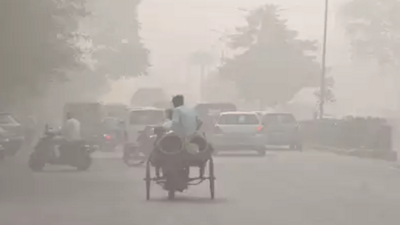- News
- City News
- ludhiana News
- Dirty air: Many region cities beat national capital
Dirty air: Many region cities beat national capital

The air quality in Punjab and Haryana took a sharp dip on Wednesday, a day after Gurpurb. Post-celebrations, and due to increase in stubble burning incidents, the air quality index (AQI) in both states slipped to "very poor" category and even to "severe" category at some places.
PATIALA/KARNAL: The air quality in Punjab and Haryana took a sharp dip on Wednesday, a day after Gurpurb. Post-celebrations, and due to increase in stubble burning incidents, the air quality index (AQI) in both states slipped to "very poor" category and even to "severe" category at some places.
AQI levels of 449 and 447 were recorded in Kurukshetra and Ambala, respectively, making these more polluted than the national capital of New Delhi (260) as well as NCR cities in Haryana.
The air quality in several districts of Haryana fell to new lows. Kurukshetra and Ambala were in "severe" category for the first time this season. In Punjab, Khanna was the most-polluted city, recording an AQI of 417 followed by Ludhiana (408).
Panchkula had an AQI of 330, pushing it into the “very poor” zone. Barring Panipat (320), rest of NCR cities showed moderate or mild pollution in AQI levels. On the other hand, Khanna remained the most polluted city of Punjab, recording an AQI of 417 followed by Ludhiana (408).
So far, this paddy harvesting season, Punjab has witnessed the highest pollution level on Wednesday, recording an average AQI of 344, as per the data of Central Pollution Control Board (CPCB). On Tuesday, the average AQI of Punjab was recorded at 205 (poor category) whereas on Monday the average AQI was 148 (moderate). On Wednesday, the monitoring stations at Khanna and Ludhiana recorded severe category pollution, with Khanna witnessing AQI levels of 417 and Ludhiana 408.
On November 8, Khanna had an AQI of 207 (poor category) and Ludhiana 351 (very poor). Patiala had leves at 368, Jalandhar 333 and Amritsar 320 -- under the "very poor" category. However, Mandi Gobindgarh surprisingly had the lowest pollution at 219. On Tuesday, too, the AQI value was the lowest at 105 (moderate category).
On Tuesday, Jalandhar had AQI values of 177 and Amritsar 140 (moderate), but plunged to a very poor category only in a day. Chandigarh, the joint capital of Punjab and Haryana also had an AQI of 400, only one notch below the severe category. While Delhi's level was at 260, which falls in the "poor" category.
As per the CPCB bulletin, the AQI was in very poor category in Kaithal (391), Yamunanagar (371), Karnal (337), Panchkula (330), Panipat (320), and Fatehabad (308). The air quality of five cities and towns including Sirsa (276), Faridabad (248), Ballabgarh (216), Hisar (215) and Jind (211), too fell in the poor category.
The AQI was a 24- hour average calculated from 4pm on November 8 to 4pm on November 9. An AQI between 0-50 is considered ‘good’, 51-100 ‘satisfactory’, 101-200 ‘moderate’, 201-300 ‘poor’, 301-400 ‘very poor’, and 401-500 ‘severe’. An AQI above 500 falls in the ‘severe plus’ category.
On Wednesday, as many as 69 fresh cases of crop stubble burning were reported in Haryana. With this, the number of active fire locations (AFLs) reached 2,693 since September 25. Karunesh Garg, PPCB member secretary said, "The change in weather conditions and lack of dispersion of smoke are some major reasons behind the rise in AQI level of Punjab. The downfall in temperature and calm conditions of windflow in Punjab, including Patiala, Ludhiana, Amritsar are some other factors.
AQI levels of 449 and 447 were recorded in Kurukshetra and Ambala, respectively, making these more polluted than the national capital of New Delhi (260) as well as NCR cities in Haryana.
The air quality in several districts of Haryana fell to new lows. Kurukshetra and Ambala were in "severe" category for the first time this season. In Punjab, Khanna was the most-polluted city, recording an AQI of 417 followed by Ludhiana (408).
Panchkula had an AQI of 330, pushing it into the “very poor” zone. Barring Panipat (320), rest of NCR cities showed moderate or mild pollution in AQI levels. On the other hand, Khanna remained the most polluted city of Punjab, recording an AQI of 417 followed by Ludhiana (408).
So far, this paddy harvesting season, Punjab has witnessed the highest pollution level on Wednesday, recording an average AQI of 344, as per the data of Central Pollution Control Board (CPCB). On Tuesday, the average AQI of Punjab was recorded at 205 (poor category) whereas on Monday the average AQI was 148 (moderate). On Wednesday, the monitoring stations at Khanna and Ludhiana recorded severe category pollution, with Khanna witnessing AQI levels of 417 and Ludhiana 408.
On November 8, Khanna had an AQI of 207 (poor category) and Ludhiana 351 (very poor). Patiala had leves at 368, Jalandhar 333 and Amritsar 320 -- under the "very poor" category. However, Mandi Gobindgarh surprisingly had the lowest pollution at 219. On Tuesday, too, the AQI value was the lowest at 105 (moderate category).
On Tuesday, Jalandhar had AQI values of 177 and Amritsar 140 (moderate), but plunged to a very poor category only in a day. Chandigarh, the joint capital of Punjab and Haryana also had an AQI of 400, only one notch below the severe category. While Delhi's level was at 260, which falls in the "poor" category.
As per the CPCB bulletin, the AQI was in very poor category in Kaithal (391), Yamunanagar (371), Karnal (337), Panchkula (330), Panipat (320), and Fatehabad (308). The air quality of five cities and towns including Sirsa (276), Faridabad (248), Ballabgarh (216), Hisar (215) and Jind (211), too fell in the poor category.
The AQI was a 24- hour average calculated from 4pm on November 8 to 4pm on November 9. An AQI between 0-50 is considered ‘good’, 51-100 ‘satisfactory’, 101-200 ‘moderate’, 201-300 ‘poor’, 301-400 ‘very poor’, and 401-500 ‘severe’. An AQI above 500 falls in the ‘severe plus’ category.
On Wednesday, as many as 69 fresh cases of crop stubble burning were reported in Haryana. With this, the number of active fire locations (AFLs) reached 2,693 since September 25. Karunesh Garg, PPCB member secretary said, "The change in weather conditions and lack of dispersion of smoke are some major reasons behind the rise in AQI level of Punjab. The downfall in temperature and calm conditions of windflow in Punjab, including Patiala, Ludhiana, Amritsar are some other factors.
FOLLOW US ON SOCIAL MEDIA
FacebookTwitterInstagramKOO APPYOUTUBE
Start a Conversation
end of article









